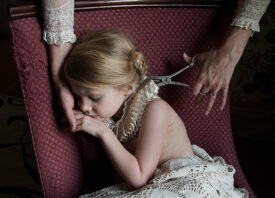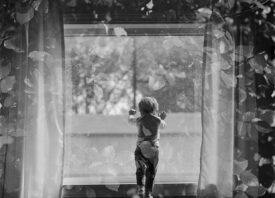Search this site
CENTER’s 2022 Award-Winners Explore Depression, Family Ties, Climate Action, & More



For the first time in 124 years, a statue in Charleston, South Carolina comes down, as part of an overdue reckoning with our nation’s legacy of racial injustice. In Guatemala, a photographer tries to make sense of a traumatic event that happened in his childhood. In New Mexico, farmers turn to regenerative agriculture, while across the world, in a seaside town in Ghana, fishermen struggle to survive as foreign fishing vessels deplete their waters.
One artist, navigating her 40s and grieving the loss of her father, finds a way to show us what depression feels like. Another tries to see the world through the eyes of her nephew, who has a rare and severe form of epilepsy.
These are just a few of the projects recognized by the non-profit CENTER Santa Fe as part of their Grants and Award program, given annually to photography projects completed and in progress. The nine artists chosen this year use different tools, media, and approaches to examine some of the most critical issues of our time, including climate change, systemic racism, and mental health.

To start, the winner of the Development Grant, which provides support to a project in progress, is Maximilian Thuemler, whose work has taken him along the coastal areas of Georgia and South Carolina. Born From the Limb comprises self-portraits, performances, landscapes, and still lifes that together tell the story of places that carry the weight of a traumatic history. On Jekyll Island in Georgia, he takes us back to the site where the Wanderer, a ship carrying hundreds of kidnapped and enslaved West African people, once made its landing.

In Charleston, Thuemler shows us Gadsden’s Wharf, one of several South Carolina ports through which an estimated one hundred thousand enslaved people were forcibly brought into the United States. And in Marion Square, he arrives at the place where a looming statue of John C. Calhoun once stood. He photographed that spot in September of 2020, just months after it was removed; in place of Calhoun, a longtime defender of slavery, there’s only open sky and sunlight.


David Walter Banks, the winner of CENTER’s Launch Grant, grounds his work in the landscape as well, while providing a glimmer of hope as to how the future might be different from the past. His project, Practice Resurrection, shows an alternative to industrial food production, following people like Ron Finley, whose urban gardening project feeds people throughout South Los Angeles, where he grew up, and Leslie Wiser and Sarah Deragon, who run a community-supported agriculture farm in California.


CENTER’s Environmental Award goes to Esha Chiocchio, whose project Good Earth covers regenerative agriculture in New Mexico, revealing how farmers are sequestering carbon, improving soil health, and creating stronger communities. From the planting of drought-tolerant trees to the practice of urban rain-catching, she shows how people are pulling together and getting creative to help address the climate crisis.


The Multimedia Award winner is Dan Fenstermacher, who also covers food and the environment, albeit thousands of miles away. Food Chain is the story of fishermen living and working in the towns of Ada, Ghana, and Prampram, Cape Coast, where their families have lived and worked for generations. As he learned while visiting last summer, these fishermen, and their families and communities, are now facing significant pressure due to overfishing from foreign vessels and an increase in plastic pollution. Their future is uncertain.


The idea of history, memory, and trauma emerges once more and in different forms in the work of the photographer Luis Corzo, who takes home CENTER’s Social Award. Pasaco, 1996 retraces an event that happened in the artist’s family when he was a young child in Guatemala; in 1996, he and his father were kidnapped and held for ransom by the organized crime group Los Pasaco.
Corzo’s father was tortured and held for 30 days, and Corzo was released after 33. The project combines archival documents and media with Corzo’s photographs of significant locations and the people whose lives were affected by what happened, weaving together a one-of-a-kind investigation that touches on crime, violence, and capital punishment.
CENTER recognizes photographers working across genres, from documentary to fine art and everything in between. Jess T. Dugan, the judge for the Social Award, also named two Honorable Mentions: one, one thousand… by Debe Arlook and A Permanent Home in the Mouth of the Sun by Hannah Altman.


In different ways, family becomes a connective thread tying each of Dugan’s selections together. Arlook tells the story of a mother and son: her sister Lori and nephew David. David, now 28, has Lennox-Gastaut Syndrome, a rare but severe form of epilepsy; Lori is his caregiver. Lori’s spiritual practice and David’s ways of perceiving the world helped inform Arlook’s process. While David is non-verbal, she asked–and received–his permission to create the project.


Altman, meanwhile, threads together stories, rituals, and symbols from Yiddish folklore to create a complex tapestry illustrating the Jewish Diaspora. A Permanent Home in the Mouth of the Sun represents a series of “photographs born from Jewish memories,” drawing on ancestral knowledge and a past marked by tradition and resilience to create a poetic and non-linear visual narrative.


Arista Slater-Sandoval, the winner of CENTER’s Personal Award, approaches the idea of home from another perspective, challenging notions of the feminine ideal in the domestic space. Her project Parable for Hysteria reimagines the home as a site that’s at once ordinary and fraught, evoking feelings of pain or discomfort. While grappling with timeless themes, the work also speaks to a singular moment in time, coming on the heels of a pandemic that kept many of us homebound and disproportionately affected women.

The Me&Eve Grant is awarded by CENTER annually to one woman, non-binary, or two-spirit photographer over the age of forty. Heather Evans Smith is this year’s winner, taking home the title for her quiet and haunting series Blue.
The project illustrates the experience of depression in women over forty. Smith was inspired, in part, by research indicating that “women are the most depressed at age 44,” the same age she was when she embarked on the project. The color blue runs throughout the work, a nod to the use of the word “blue” to mean sadness.
You’ll also find references to the artist’s childhood and her father, whose loss she continues to mourn, carefully woven throughout. In one picture, she’s included a pair of cerulean shoes, a homage to her dad, who often wore Bass Weejuns.

“The funny thing about working on a series about depression is that it is nearly impossible to do when you are down in it,” Smith shared on Instagram recently. She took a break from the work in 2020, returning to it last year. “This past year just felt right,” she said. “The images flowed through me.”
Be sure to check out CENTER’s winners’ page to explore more from this year’s grantees and award-winners. Their work will be presented in November as part of Review Santa Fe, CENTER’s influential portfolio review event.



